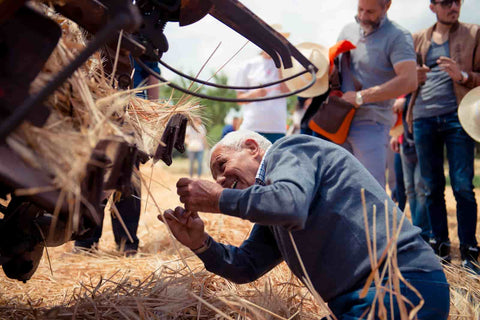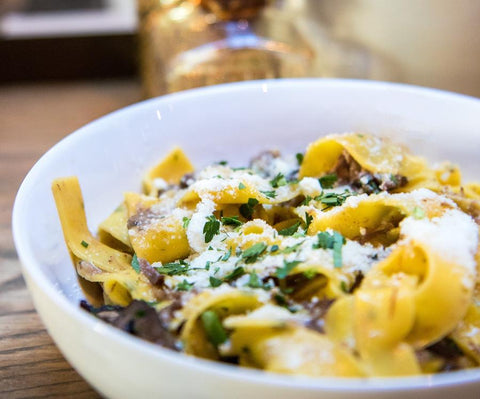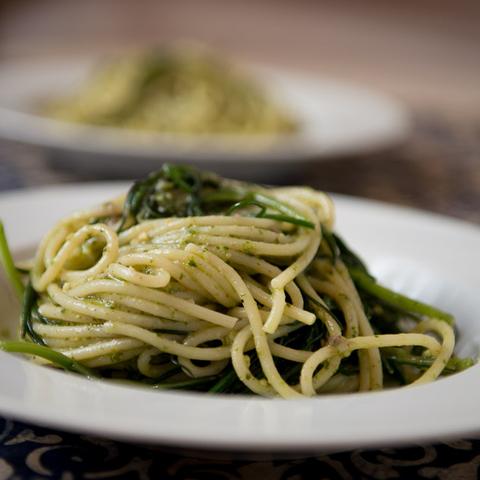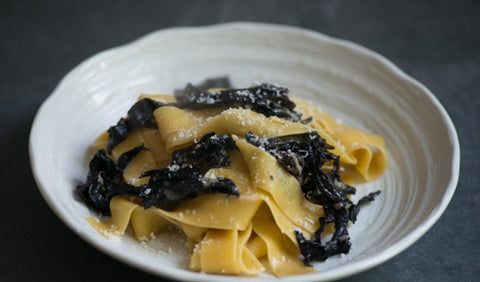Everything You Need To Know About The Best Italian Dried Pasta
by Holly Thomson

The Italian hill town of Gragnano sits on the southern slopes of Mount Vesuvius just north of the Amalfi coast. But it’s not just the views that put Gragnano on the map. The town is home to some of Italy’s finest dried pasta – in fact Gragnano’s pasta is the only dried pasta in Italy that has protected IGP status.
What makes the best dried pasta?
The town of Gragnano enjoys a unique combination of Mediterranean sea breezes, shelter from the Apennine mountains, and summer humidity – perfect conditions for drying pasta. Pasta has been hung out to dry from rods in the town’s streets for many hundreds of years. It’s even said the town’s layout is specifically designed to allow sea breezes to travel as far as possible through the streets, drying rows of pasta as it goes.
There are three main factors that contribute to Gragnano pasta's IGP status:
-
Durum wheat flour
Gragnano IGP pasta must be made with durum wheat. The Gragnano-based company Pastaficio dei Campi goes one step further and uses 100% Italian-grown durum wheat, unlike much of the dried pasta in Italy which in fact uses Canadian wheat. This wheat is carefully selected to give the pasta fantastic flavour. It also means each packet of pasta can be traced back to an individual field in Puglia, using a tracking code printed on the side of every box.
-
Bronze die cut
To qualify for the IGP status, pasta from Gragnano must be shaped and cut with a bronze die, and not a modern teflon die. This crucially gives the pasta a rougher surface, which means sauces will coat it better – and in turn means you’ll have more flavour in every mouthful.
-
Slow drying
Pasta from Gragnano is dried slowly. This retains the pasta’s pale colour, because the starch content isn’t over-heated. You can easily see the difference between slow and fast-dried pasta. Fast-dried pasta is often golden yellow and almost translucent (because the starch has coloured and cooked in the drying process). Meanwhile slow-dried pasta is milky pale, opaque and still looks slightly floury.

What are the different types of dried Italian pasta?
There are regional differences between pasta recipes. In the north of Italy, pasta is commonly made with eggs. While the southern Italian recipe uses just water and flour.
Both types of pasta can be dried, and the recipe made with eggs will produce a rich yellow pasta thanks to the yolks. Egg pasta is traditionally a more decadent recipe, whereas pasta made simply with water and flour forms part of the country's cucina povera heritage – using scant resources to make beautifully simple dishes.
Pasta di Aldo's artisan egg dried pasta is a favourite of Michelin chefs. The company hand-makes pasta in the Medieval town of Monte San Giusto on the east coast of Italy.
Chef Heston Blumenthal says: "La Pasta Di Aldo... captured the opposites that characterise great pasta – good body, but with a lightness; a rich flavour that doesn’t overpower; substance twinned with a delicacy – and the colour was fantastic: a vivid yolk-yellow that signalled a high egg content and the use of durum wheat semolina, the hard flour that is vital to good pasta. It was clear that my next trip to Italy would have to include a visit to Monte San Giusto to see if Luigi Donnari would let me in on how he created it."
Pasta di Aldo pappardelle egg pasta has a rich and refined flavour – this is one pasta you won't want to smother with sauce!
Serve the wide ribbons simply with a little butter or high quality olive oil and black pepper, to let the flavour of the pasta shine through.
Pasta di Aldo truffle tagliatelle egg pasta is a luxurious meal in minutes. Serve the pasta simply with a little butter and a sprinkle of Parmesan and enjoy the flavour of rich egg pasta and black summer truffle. For real mushroom lovers, serve the truffle tagliatelle with a medley of wild mushrooms sautéed in butter and finish with a little parsley.
What is the most famous pasta in Italy?
Globally, the most famous Italian dried pasta shapes include spaghetti, fusilli and penne. However, on home soil, Italians enjoy hundreds of different pasta shapes and each region is famed for a signature type – which is usually served with a specific style of sauce.
The Gragnano region has several signature shapes, including world-famous penne, conchiglie, and tortiglioni. Here are some of the pasta shapes from southern Italy, available from Pastaficio dei Campi:
This delicate pasta takes its name from the Italian for ‘little ears’ thanks to its round shape. It is made using a special machine called the baresina. When made by hand, the discs of pasta are rolled flat, then pushed out against a flat surface with the thumb to create the signature curl.
Traditionally, orecchiette is eaten with tomato sauce, broccoli, meatballs, or ricotta cheese.
Long slightly flattened pasta from Genoa and the Ligurian coast. This classic chape is often served with seafood or a punchy Genoese pesto. Linguine with clams is also a classic Gragnano dish.
3 Recipes with dried pasta
Pasta with mushrooms & hazelnut oil
Pasta with pan-fried mushrooms and garlic is already a crowd-pleasing combination. Add in the sweet-savoury nutty flavours of Pariani hazelnut oil and you’ve got an irresistible meal that’s effortless in its execution.
Wild garlic spaghetti
Foraged wild garlic is a joy of early spring. Use it to make a simple pesto and serve with the best spaghetti you can get your hands on.
Parpadelle & trompette mushrooms
Dried mushrooms are a fantastic store cupboard ingredient. Simply rehydrate and fry off with a little garlic, Parmesan and lemon zest and serve with silky pappardelle pasta.
For more ways to serve pasta, read our recipe for pistachio oil and pine nut pesto pasta sauce, and browse our collection of pasta, rice and noodles.











